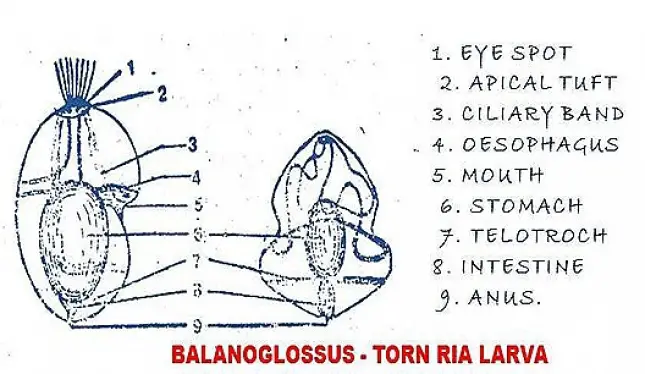Medically reviewed and approved by a board-certified member
Zoology
REPRODUCTIVE SYSTEM, AND EMBRYO DEVELOPMENT IN BALANOGLOSSUS
By BS MediaTwitter Profile | Published: Monday, 05 June 2017

Balanoglossus performs asexual and sexual reproduction.
Asexual Reproduction: Gilchrist described asexual reproduction in Balanoglossus capsensis. In the summer season its posterior end will divide into a number of bits. Each bit will develop into a new individual.
Sexual Reproduction: Sexes are separate, sexual dimorphism is absent. The gonads are simple. They are present in one or many rows in the branchio-genital region.
Each gonad will give gonoduct. This gonoduct will open out through a pore externally. In male the gonads are called testes. They produce sperms. In female the gonads are called ovaries. They produce ova. They are liberated into water. Fertilization will take place in water. It is called external fertilization.
The fertilized zygote will undergo holoblastic clevage.
- In Balanoglossus kowaiowsley the development is direct. No larval form is seen in its life history.
- In other species of Balanoglossus a larval form called 'Tonaria" is seen in the development. It Will undergo metamorphosis and becomes adult.
Development:
- The fertilized egg contain some yolk. It is meselecithal egg.
- It undergoes holoblastic clevage.
- Because of clevage it gives Morula, blastula stages.
- In Blastula stage a cavity is present called Blasto coel.
- The blastula is round in the beginning then it becomes flat.
- It undergoes invagination and gives two layered gastrula.
- This stage will show blastopore, which will slowly closer.
- This stage will develop cilia.
- It will also develop apical tuft.
- It shows ectoderm and endoderm.
- It will develop enterocociic coelom.
- At this stage the ciliated embryo will be liberated into water. It elongates and transforms into Tornaria" larva.
Tornaria Larva:
- Mulier proposed the name Tornaria". He considered it as Fxhinoderm larva.
- Metacoff first identified it as the larva of Balanoglossus
- This larva free swims in the sea water.
- It is oval in shape.
- It is transparent.
- Its ciliary bands are pre-oral and post-oral ciliated bands.
- It shows distinct digestive tract. It opens with mouth on the ventral side. At the posterior end it opens out through anus. This tract is curved.
- It will swim with the help of cilia.
a) Pre oral band of cilia is significant one. It surrounds the mouth and then it transforms as post oral band of cilia.
b) Around anus a band of cilia is present called anal ciliated band. - Tornaria takes micro-organisms of sea water as food.
- It shows two eye spots and nerve cells.
- It can notice the light intensity with the help of eye spots.
This larva after leading a free swimming lobe for some time it will transform into adult. It is called metamorphosis.
Metamorphosis:
- Eye spots and ciliated bands will slowly reduce.
- By the development of two constrictions in the body, it is divisible into 3 parts.
a. anterior part proboscis
b. Middle part collar
c. Posterior part trunk - Trunk will grow quickly more than proboscis and collar.
- In the pharynx gills are developed.
- In the intestinal region hepatic caecae are developed.
- Stomochord, Pygochord etc. will be developed.
- Heart, blood vessels, and glonurukis are developed.
- Coelom will be divided into 5 cavities.
- From ectoderm nervous system is developed.
Thus slowly the tornaria will transform into adult. It will sink into the water. It will lead burrowing life.
Tags:
End of the article